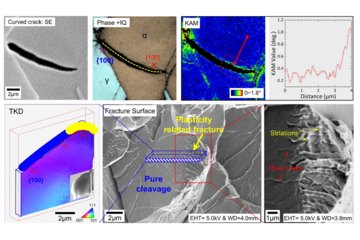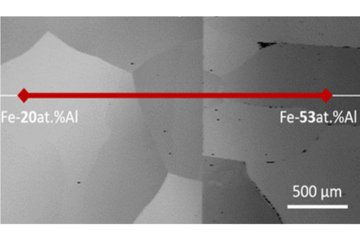All genres
121.
Talk
Interstitially alloyed high-entropy alloys with improved mechanical properties. Thermec 2018, Paris, France (2018)
122.
Talk
Hydrogen enhances strength and ductility of an equiatomic high-entropy alloy. Thermec 2018, Paris, France (2018)
123.
Talk
The cyclic plasticity behavior of interstitial TWIP-TRIP-HEA. Thermec 2018, Paris, France (2018)
124.
Talk
On the fatigue behavior of dual-phase high-entropy alloys in the low-cycle fatigue regime. Fatique 2018, Poitiers, France (2018)
125.
Talk
Carbon and Nitrogen Co-doping in an Equiatomic High-entropy Alloy. TMS 2018 Annual Meeting & Exhibition, Phoenix, AZ, USA (2018)
126.
Talk
Tuning Phase Transformation in Compositionally Complex Alloys for Superior Mechanical Properties. TMS 2018 Annual Meeting & Exhibition, Phoenix, AZ, USA (2018)
127.
Talk
Hydrogen Resistance of C-doped and Undoped CoCrFeMnNi High-entropy Alloys. TMS 2018 Annual Meeting & Exhibition, Phoenix, AZ, USA (2018)
128.
Talk
Mechanical Behavior and Thermal Stability of a Dual-phase Complex High Entropy Alloy. TMS 2018 Annual Meeting & Exhibition, Phoenix, AZ, USA (2018)
129.
Talk
Phase Stabilization of High Entropy Alloy under Dynamic Forcing Condition. TMS 2018 Annual Meeting & Exhibition, Phoenix, AZ, USA (2018)
130.
Talk
Interstitial transformation-induced plasticity-assisted quinary CCAs/HEAs:Design, structure and mechanical behavior. DFG Schwerpunktprogramm Compositionally Complex Alloys – High Entropy Alloys (CCA-HEA)” (SPP 2006), Leibniz Universität Hannover, Hannover, Germany (2018)
131.
Talk
1 Billion Tons of Nanostructure - Metastability Alloy Design and Segregation Engineering. 38th Risø Intern. Symp. Materials Science Advanced Metallic Materials by Microstructural Design , Roskilde, Denmark (2017)
132.
Talk
Metastability Alloy Design. 16th Intern. Conference on Rapidly Quenched and Metastable Materials (RQ16), Leoben, Austria (2017)
133.
Talk
Designing novel high-entropy alloys towards superior properties. Frontiers in Materials Processing Applications, Research and Technology (FiMPART'2017), Bordeaux, France (2017)
134.
Talk
Designing and understanding novel high-entropy alloys towards superior properties. Talk at Universität Kassel, Institut für Werkstofftechnik, Kassel, Germany (2017)
135.
Talk
Chemo-Mechanics at Lattice Defects: from Mechanisms to Bulk Alloys. Gordon Research Conference on Thin Film & Small Scale Mechanical Behavior, Lewiston, ME, USA (2016)
136.
Talk
Shear Transformation in a Non-Equiatomic CoCrFeMnNi High-Entropy Alloy. 2016 MRS Fall Meeting, Boston, MA, USA (2016)
137.
Talk
Designing and understanding novel alloys towards superior properties. 2016 European Workshop on Materials Design, Grenoble, France (2016)
138.
Talk
Metastable High-Entropy Dual-Phase Alloys with Joint Increase in Strength and Ductility. 2016 MRS Fall Meeting, Boston, MA, USA (2016)
139.
Talk
Interstitial Compositionally Complex Alloys with Transformation and Twinning Induced Plasticity. 2016 MRS Fall Meeting, Boston, MA, USA (2016)
140.
Talk
Thermodynamics and Mechanical Properties of Non-Equiatomic CoCrFeMnNi Alloys. 2016 MRS Fall Meeting, Boston, MA, USA (2016)











